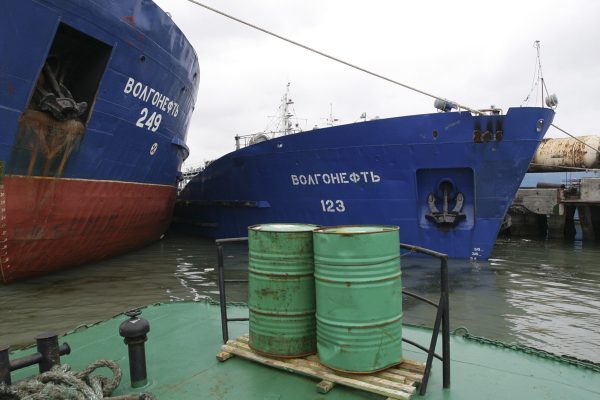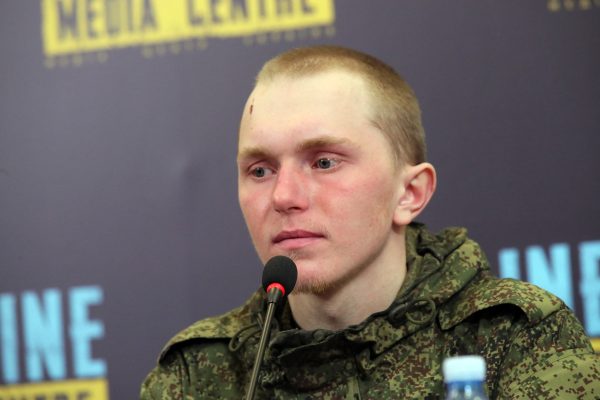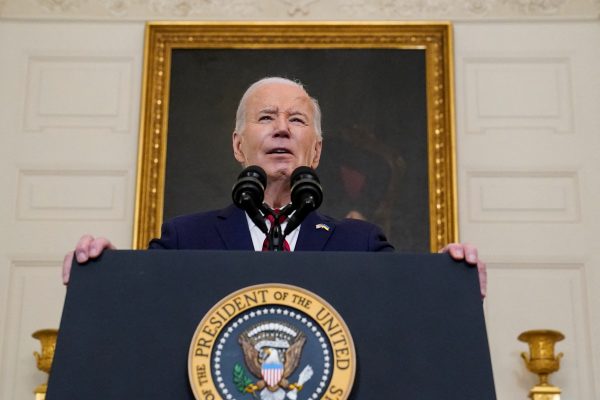A leaked German defense ministry paper outlining the start of a full-scale Russian attack on the Baltic states and Poland — and thereby NATO — is artfully imagined.
The scenario begins with the Putin regime mobilizing as many as 200,000 new conscripts in February. This would aim to raise pressure on Ukraine, while Russia’s army initiated a quiet build-up on the borders of Poland and Lithuania near the Suwałki Corridor. The German paper suggests this would trigger a NATO buildup, and be followed by a Russian attack at the year’s end, just as Donald Trump returns to office (US voters allowing.)
How might it go after that? The old military maxim states that if you want to understand your adversary, put yourself in his shoes. So I have followed the scenario to its likely conclusion.
Russian generals would need to start war planning immediately. The Kremlin loves a mighty name on a war plan, much like their American counterparts, who spend a lot of energy and time to come up with the most appealing name.
Given the old Soviet-era war plan “Seven days to the Rhine,” the proposed operational name will be “Plan Red — Three Days to Paldiski (a small community on the Baltic Sea just west of the Estonian capital, Tallinn.) This name was adopted the moment it hit the desk of Vladimir Putin, who admired its historical echoes.
First, the assumptions behind the plan must be agreed upon. This would be done under five general headings.
First, most Western European armed forces are in a grave state of unreadiness and have limited abilities. Even significant forces such as Germany, France, and Great Britain talk big, and as their politicians market impressive-sounding rearmament programs. But at the unit level, readiness is the same as it was 10 years ago.
The first significant NATO formation to arrive at the Lithuanian border would be Polish, after about 72 hours, but sizeable German and other European NATO forces will not be seen for at least 10-15 days. This, it goes without saying, is a dire start because the small NATO tripwire forces (which total about 6,000-7,000 personnel) in the Baltics rely on relief arriving fast. A German pledge to send an additional brigade of 4,000 troops has not yet materialized.
West European NATO members are in a state of denial about their readiness and inhabit an imaginary world where recent pledges of rearmament are already in place.
One example is the key Swedish island of Gotland, which commands access to much of the Baltic Sea but is still only defended by one mechanized company (barely a few hundred personnel) and some home guard forces.
This chasm between imagined readiness and actual readiness presents Russia with an excellent opportunity.
Second, since the Cold War the fear and ignorance about nuclear arms in Western Europe has built to such an extent they are no longer discussed. At all. At least in the 1970s and 1980s, there was a conversation, even if it came from nuclear abolitionists.
Added to the silence about nuclear arms is the almost 80-year-old geopolitical equilibrium where nuclear arms are never used and are seen as theatrical instruments solely to demonstrate strategic deterrence.
The Russians have no such difficulties and well know how they can be used for effect. The use of relatively small nuclear arms would send the West into a steep economic nosedive. The shock waves would cause widespread popular panic but would also shake political and military leadership and systems. It would cause utter mayhem in the financial markets.
The 9/11 attacks were not only a deadly event in human terms, they also created market chaos. US markets were closed for five days and lost $1.4 trillion in value in the week they reopened. A nuclear weapon detonation is unquestionably the sort of black swan event that terrifies investors and Western central banks would struggle to restore equilibrium.
It’s true that nuclear weapons use is not nice, but Russia doesn’t worry about nice. It worries about the effect.
Third, as the Russian planner, I would assess that NATO “trip wire” forces in the Baltics will be essentially passive. They lack sufficient artillery, logistics, and medical support, and have few heavy weapons to engage a Russian spearhead.
So I would circumvent these NATO units and once this is achieved there will be little serious interference in our operations during the first 72 hours. Rather than attack us, the NATO “trip wire” units will hold the territory where they are stationed.
Finland will not have time to mobilize or push units toward Russia, nor will it cross the Russian border, fully aware of the risk of a nuclear response. Russia can thus keep its military units unchanged in that area. They will not need to be reinforced.
Fourth, we will ensure surprise. Western observers like to say that Russians have proved themselves bone-headed in the failed war on Ukraine. That’s true. We made some terrible mistakes, but we also learned.
So rather than weeks and weeks of build-up (as with Ukraine) we will launch the offensive with what we have on the frontline. Yes, NATO will have noticed some military strengthening but it won’t be sure. We will not share our intentions with much of our own government or foreign entities; even China will be unaware.
And we can rely on our friends on Western social media to spread our lies, as they did over Ukraine. Many others will suggest high-level talks. We like high-level talks; they keep everyone busy until it’s too late.
Meanwhile, Russia’s other weapons of war, our gray zone units, will continue to work at full pitch. Their messaging machine will be careful not to blow the cover of the operation, indeed they will deny it and sow confusion about our real aims. Practiced propaganda and psychological operations will get underway, including thousands of fake social media accounts under Anglophone names explaining the problem is once again NATO aggression. There will be peace demonstrations across Western cities.
We Russians know the considerable military risks. A small invasion force might repeat our humiliation at Hostomel airport near Kyiv in February-March 2022 when lead units were annihilated by the Ukrainian army. Audacity, we learned, has its price. But we won’t make the same mistake twice.
The actual plan is simple.
Plan Red.
Day one, the war begins with an intensive missile barrage on high-value targets. An echelon of armor, attack helicopters, and rocket artillery pushes through Northern Estonia-Narwa and Tallinn to Paldiski. Simultaneously, battalion-size naval infantry landed in Tallinn harbor.
In the south, a second echelon pushes northwestwards from Belarus toward Kaliningrad Oblast through Lithuania and then immediately turns south to confront NATO forces coming from Poland. Rear echelon forces mop up the Lithuanian defenses and resistance in the following days.
Latvia is ignored and sits in the Kurland Kessel, the Courland pocket. Its army lacks the means to attack and is effectively removed from the board.
Now comes the drama. A relatively small, high-altitude nuclear device is exploded over international waters releasing a significant electromagnetic pulse (EMP) to knock out communications and computer systems on Gotland, including the main town of Visby, after which a battalion-sized airborne unit captures the nearby airfield. Day two is taken up with securing day one’s targets and reinforcing first-echelon forces.
When the Polish army arrives at the main frontline on day three, the Kremlin informs NATO that any attempt to reoccupy Russia’s new Baltic oblasts will trigger a nuclear response.
After calling Washington to forewarn it — and so avoid triggering a US nuclear response — Russia’s Strategic Rocket Forces launch missiles that explode on its own territory – targeting the Russian borderland in Novaya Zemlya, the large island north of Murmansk, and minor islands the East Siberian Sea in the Far East. This will not kill many Russians (most would be indigenous people and the Kremlin is indifferent to their welfare) but it would underline how far Putin’s regime is willing to go.
Allied intelligence meanwhile warns that its satellites and sensors have detected Russian strategic missile submarines putting to sea in unusual numbers in the previous weeks. Now it’s clear why.
The Kremlin explains to the West that it is a reasonable partner and wishes to restore fraternal relations. Yes, this has been a historic humiliation for the West and yes it must be painful to see the end of its supposed rules-based global order (which it always considered ridiculous and unfair.)
Russia offers a deal. We take the Baltic states, plus a land corridor across the remains of a partitioned Ukrainian state. Oh and Moldova; we’ll have that too.
After all, you’re in no position to negotiate. There is nothing to negotiate about.
And because we’re reasonable and seek brotherly relations, you can have Gotland back as a sign of goodwill.
What do you say?
Jan Kallberg, Ph.D., LL.M., is a non-resident Senior Fellow with the Transatlantic Defense and Security program at the Center for European Policy Analysis (CEPA), a non-resident Fellow at the Army Cyber Institute at West Point, and a George Washington University faculty member. Follow him at cyberdefense.com and @Cyberdefensecom.
Europe’s Edge is CEPA’s online journal covering critical topics on the foreign policy docket across Europe and North America. All opinions are those of the author and do not necessarily represent the position or views of the institutions they represent or the Center for European Policy Analysis.
Footnotes
balt





